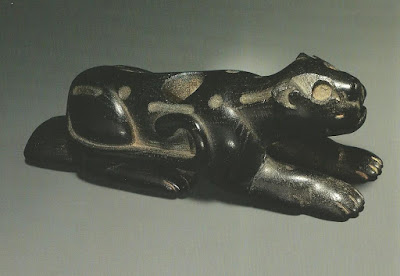Spotted cat petroglyph, Farrington Springs,
Bent County, CO. Photo Peter Faris, 1990.
On May 1, 2009, I posted a column titled "A Spotted Cat Petroglyph In Southeastern Colorado." In this I showed a petroglyph from the marvelous rock art site of Farrington Springs and speculated as to exactly what it represents. The petroglyph, of an animal covered with spots and with a long tail and small ears appears to represent a cat, so then we ask ourselves what kind of cat? The first guess of a spotted cat that might live in that locale would be a young bobcat as they are covered with spots. Bobcats, however, have short little stubby tails, and this cat has a long tail sticking out behind him. Also, this animal is obviously not meant to represent a young animal as it has the phallus of a fully grown male animal.
In that posting I wrote "So what kind of cat is this? Other examples of spotted cat imagery can be located in Native American art. One that can be pointed to is the image on the painted model tipi (above), owned by the Field Museum, Chicago, which was collected in 1904 by Smithsonian ethnologist James Mooney and was displayed at the Buffalo Bill Historical Center at Cody, Wyoming, when the photograph above was taken. Another example I have seen is a carved stone pipe shaped as a spotted cat, attributed to the Mississippian culture. That carved stone pipe has been identified as an ocelot, which is one of the possibilities for identity of the spotted cat. The closest report of an ocelot sighting that I have been able to locate was somewhere along the Texas/Oklahoma border which might fall within about 100 miles from the petroglyph site. The other possibility for a long-tailed spotted cat is the jaguar, sightings of which are still reported irregularly throughout the southwest. In either case (ocelot or jaguar), they are now extinct through much of their former range in the southwest, and even in prehistoric times were probably quite rare. This suggests that the sighting of one of these animals was a significant event, worthy of reproducing on your tipi, your pipe, or on the cliff." (Faris 2009)
Panther pipe, Hopewell, AD 1 - 400, Mann
Site, Posey County, Illinois, from Townsend,
2004, Hero, Hawk and Open Hand, p. 63.
Another source of comparative imagery can be found engraved on a shell gorget which has been attributed to the Hopewell culture and is the Missouri State Artifact. This so-called Jaguar Gorget was excavated from a mound near Fairfield, Missouri, and is assigned to the Kansas City Hopewell based upon associated artifactual evidence.
This then brings up the question of the time period during which jaguars and ocelots roamed eastern North America coexisting with people.
"The Pleistocene fossil record proves that jaguars once ranged over most of North America. Jaguar fossils have been found as far northwest as Whitman County, Washington and as far northeast as Port Kennedy, Pennsylvania. Across the southeast jaguar fossils are among the most common of the large carnivores found by fossil collectors. Along with dire wolves they were probably a dominant predator in the region’s forests for most of the Pleistocene, being more common than the infamous saber-tooth." (Gelbart 2010)
So, what is the most likely identity of the spotted cat at Farrington Springs in southeastern Colorado? Given indications that both ocelots and jaguars might (and I emphasize might) have existed throughout much of North America in relic populations, and also given that considerably larger numbers of ocelots and jaguars existed in Mexico to stray or wander northward before the coming of the modern firearm, it appears that the identification of this petroglyph as an ocelot or jaguar is warranted.
REFERENCES:
Faris, Peter
2009 A Spotted Cat Petroglyph In Southeastern Colorado, http://rockartblog.blogspot.com, May 1, 2009.
Gelbart, Mark
2010 How Recently did the Jaguar (Panthera onca) Roam Eastern North America, https://markgelbart.wordpress.com/2010/07/08/.
Townsend , Richard F., general editor, and Robert V. Sharp, editor,
2004 Hero, Hawk, and Open Hand: American Indian Art of the Ancient Midwest and South, Art Institute of Chicago and Yale University Press, New Haven and London.
Wood, W. Raymond
2000 The Jaguar Gorget-"The Missouri State Artifact", Missouri Archaeological Society Quarterly, April-June 2000, 17(2):8-11.
2000 The Jaguar Gorget-"The Missouri State Artifact", Missouri Archaeological Society Quarterly, April-June 2000, 17(2):8-11.



